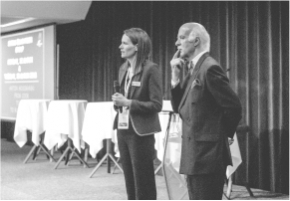- About
- Programs
- Innovation & Research
- Campus Life
- Career Services
- Admissions
- News & Events
- Alumni
What Is the Difference Between a Manager and a Leader?
Learn the difference between manager and leader. Explore key traits and start developing your leadership skills today.
Key Takeaways
- Managers focus on execution, structure, and control, whereas leaders focus on vision, people, and motivation.
- Leadership relies on influence and emotional intelligence, while management is characterised by authority and structured processes.
- Blending leadership and management skills is essential for success in the evolving, tech-driven workplace.
Imagine two people in charge of a team. One follows the plan, watches the clock, and makes sure every task is checked off. The other rallies the group with a clear vision, keeps morale high, and pushes for new ideas. Same project, same deadline—completely different dynamic. That’s the difference between a manager and a leader in action.
Companies are increasingly looking for professionals who can blend both roles—someone who can meet goals and motivate people. Understanding where you stand (and what you need to work on) is the first step toward becoming that kind of powerhouse.
Key Differences Between a Manager and a Leader
While managers and leaders often work toward the same goals, they approach challenges, teams, and decision-making differently—each with a unique mindset, style, and impact on the people around them.
Execution vs vision
Execution is all about turning goals into clear, actionable steps. It means creating plans, organizing resources, assigning tasks, and keeping everything moving forward. Managers shine in this area—they focus on how things will get done, ensuring the process is smooth, efficient, and effective. They track progress, solve problems, and make sure the team hits its targets.
Vision, on the other hand, is about seeing the bigger picture. In a leadership context, it means setting a future direction, imagining what’s possible, and inspiring others to chase that goal.
Leaders often think several steps ahead, asking beyond “How do we get this done?” but “Where are we going, and why does it matter?” While managers drive the day-to-day, leaders help teams believe in something bigger. Both are essential, but they serve very different purposes when it comes to progress and growth.
Authority vs influence
Managers typically operate through authority. They have a formal role, and with that comes the power to assign tasks, enforce rules, and expect results. Tasks set by managers are usually intended to be carried out as directed. This structure helps keep teams organized and accountable, especially in fast-paced or high-pressure environments.
Your Leadership Journey Starts Here
Master the art of hospitality management
Leaders, however, rely more on influence than authority. They earn trust, build relationships, and inspire others to follow their lead—not because they have to, but because they want to. This kind of motivation runs deeper. It sparks commitment rather than simple compliance.
While authority gets things done in the short term, influence tends to shape a stronger, more motivated team culture over time. People who feel inspired and respected are more likely to stay engaged, go the extra mile, and stick around. That’s the quiet power of influence—it lasts longer than orders ever could.
Process vs people
Another factor setting managers and leaders apart is their duties. Managers are primarily focused on building and refining processes. They create systems, set up workflows, manage resources, and ensure that procedures are followed correctly. Their role is to bring order, consistency, and efficiency to the workplace. Success for a manager is often measured by how well the team meets its goals, follows structure, and stays within budget or timelines.
Leaders, by contrast, focus on people. They work to build trust, encourage collaboration, and support individual growth. Being a leader means believing that great results will naturally follow when people feel empowered, motivated, and valued. Their efforts often lead to higher engagement, stronger creativity, and deeper loyalty within a team.
Control vs motivation
Control is about creating structure. Managers use it to set clear rules, deadlines, performance standards, and expectations. They rely on methods such as supervision, reporting systems, performance evaluations, and corrective actions to keep teams on track. This helps maintain order, reduce risks, and ensure consistency across the board.
Motivation, on the other hand, comes from within. Teams led through motivation perform 20% more efficiently, a study shows. They’re more creative, engaged, and willing to go the extra mile—not just because they have to, but because they believe in what they’re doing. Ultimately, as a leadership quote by Simon Sinek goes:
A great leader doesn't only inspire us to have confidence in what THEY can do. A great leader inspires us to have confidence in what WE can do.
Leaders aim to inspire—not by pressure, but by connecting with what drives people personally. They tap into intrinsic motivators like purpose, autonomy, the desire to improve, and the need to feel valued. This means that, instead of telling people what to do, they encourage them to want to do it.
Characteristics of a Successful Manager
A modern, high-performing manager needs a blend of skills to excel, including:
- Organizational skills: Managers must juggle multiple tasks and responsibilities. Being organized allows them to stay on top of deadlines, prioritize effectively, and keep the team’s workflow smooth.
- Strategic planning ability: A great manager can plan for the long term, setting clear goals while ensuring the team can meet them. Strategic planning involves anticipating challenges, allocating resources wisely, and adapting to changes as they come.
- Decision-making under pressure: Managers often face situations where quick decisions are crucial. The ability to stay calm, assess the situation, and make informed choices ensures that operations don’t stall, even in high-stress moments.
- Strong communication and clarity: Clear communication is key to keeping the team aligned. Managers who can convey expectations, provide feedback, and listen effectively ensure everyone is on the same page.
- Accountability and consistency: Being accountable means owning both successes and mistakes. Consistency in managing expectations, setting standards, and providing feedback builds trust and reliability within the team.
Characteristics of a Successful Leader
Leaders are defined by traits that set them apart from managers, with some of the main leadership qualities being:
- Visionary thinking: Leaders see the bigger picture and inspire others to move toward a future goal. They don’t just focus on what needs to be done today but think about how their team or organization can grow and evolve in the long term.
- Emotional intelligence: Great leaders are in tune with their own emotions and can read and respond to others’ feelings. This helps them manage relationships, build trust, and create a positive work environment where people feel understood and supported.
- Strong communication and storytelling ability: Leaders can convey their ideas clearly and connect with others through compelling narratives. By telling stories that resonate with their team, they make goals feel personal and inspire action.
- Empathy and active listening: Leaders take the time to understand their team's needs, concerns, and perspectives. Listening actively enables creating a rapport and a culture of openness and mutual respect.
- Adaptability and resilience: Leaders thrive in changing environments, embracing challenges with a flexible leadership mindset. Their resilience helps them navigate setbacks and encourages their team to stay positive and adaptable during tough times.
How to Transition from Manager to Leader
Transitioning from a manager to a leader isn’t about changing your title—it’s about evolving your mindset and approach. If you’re ready to make this shift, here are some practical tips to help guide your journey:
- Volunteer for strategic projects: Take on projects outside your usual scope to broaden your perspective. Working with different teams helps you think strategically and understand broader organizational goals.
- Schedule one-on-one check-ins: Leaders prioritize personal connections. Regular check-ins allow you to build trust, understand individual goals, and provide tailored support to your team members.
- Ask for feedback: To grow, you need to know where you’re excelling and where you can improve. Seek honest feedback to help refine your leadership style.
- Mentor a junior employee: Mentoring helps you practice empathy and develop your coaching skills. It also builds your leadership presence and enables you to invest in others’ growth.
- Focus on outcomes: Leaders are results-driven. Shift your focus from simply completing tasks to achieving meaningful, long-term outcomes that benefit your team and organization.
- Practice storytelling: Leaders inspire through storytelling. Share your vision, values, and lessons learned in a way that motivates and connects with others.
- Read leadership-focused material: Continuous learning is key. Podcasts, articles, and books on leadership will expand your knowledge and help you stay inspired.
Leadership vs Management in the Modern Workplace
The distinction between leadership and management has become more significant in the 2020s due to several key shifts in the modern workplace. The pandemic accelerated changes in work dynamics, with remote and hybrid work environments becoming more popular. This shift forced leaders to rethink how they engage, motivate, and connect with their teams without the benefit of in-person interactions.
Flatter organizational structures, which have gained traction in recent years, also challenge traditional managerial roles. With less hierarchy, leadership is less about authority and more about collaboration, influence, and fostering innovation within teams. Managers are increasingly tasked with guiding teams through decentralized work processes, but without the rigid control structures that once defined their role.
Finally, the rise of digital tools and automation has changed the way work gets done. Managers now leverage technology to monitor performance, streamline processes, and optimize workflows. Still, leaders must harness these tools to keep teams aligned, motivated, and inspired by the organization’s vision. In this landscape, leaders and managers must blend their roles more than ever to navigate the challenges of modern work.
Lead Like a Manager, Manage Like a Leader
Understanding the difference between a manager and a leader helps you grow in both roles. While managers focus on structure and execution, leaders inspire and guide teams toward a bigger vision. In the modern workplace, combining both skill sets is key. At César Ritz Colleges, you'll learn how to lead with confidence, manage with purpose, and thrive in any career path by pursuing the MS in leadership program.
Ready to build real-world leadership skills? Join César Ritz Colleges and start your journey today.
Frequently Asked Questions
Do all leaders eventually become managers?
No, not all leaders become managers. Some lead through influence, ideas, or inspiration without holding formal authority.
How can I tell if my team sees me as a leader or just a manager?
If your team follows you out of respect and shared vision—not just obligation—you’re seen as a leader, not just the person in charge.
Are you interested in a career in the hospitality business? Download a brochure to learn more about the programs at César Ritz Colleges Switzerland.
























